The small yet interesting animals known as caterpillars play a crucial role in the state of Washington’s diverse environment. In this article, we’ll go out on a tour to discover the astounding diversity of caterpillars in Washington’s rich surroundings.
From the towering evergreen forests to the vibrant meadows and tranquil wetlands, each habitat provides a unique haven for these colorful critters. With over 100 species of caterpillars identified in the state, there is no shortage of wonder to behold!
In this article, prepare for amazement by the vivid patterns and striking hues that these caterpillars adorn their bodies with! They have evolved these magnificent features to protect themselves from predators and blend seamlessly into their natural surroundings.
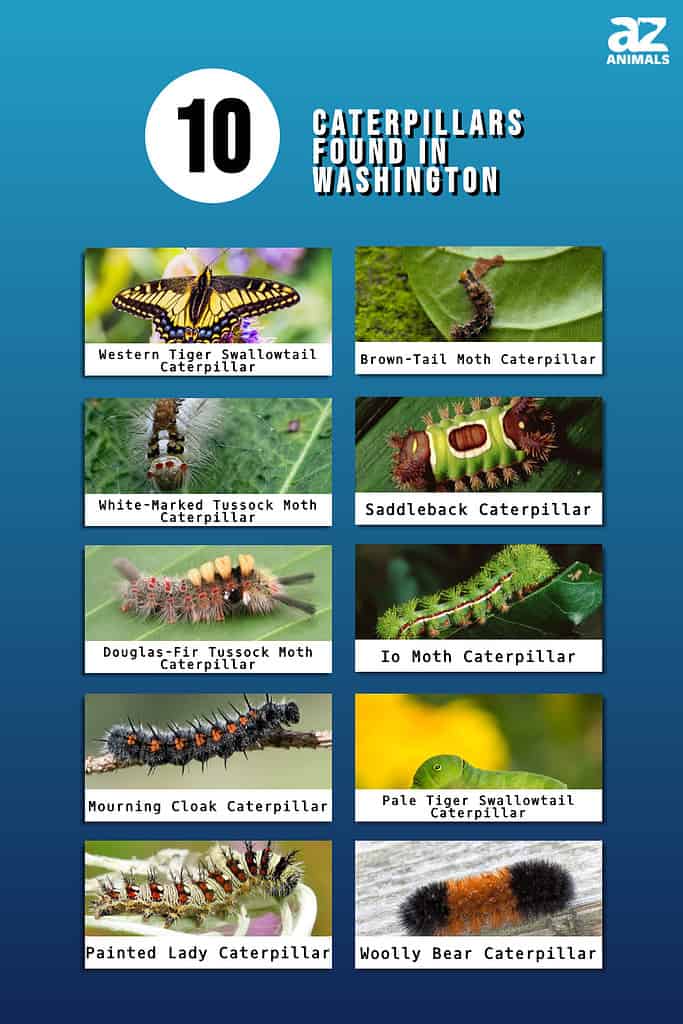
What Parts of Washington Have the Most Caterpillars?
Washington State exhibits varying caterpillar populations across its diverse landscapes. Several factors influence the distribution and abundance of caterpillars in different regions of the state.
With its coastal rainforests, the Olympic Peninsula is home to a wide variety of caterpillars. The higher elevations feature cooler temperatures, which can limit caterpillar populations. However, caterpillars are more likely to flourish in lower elevations and valleys on either side of the mountain range.
The Olympic Peninsula, with its coastal rainforests, exhibits a rich diversity of caterpillars. The mild, humid climate sustains a variety of plant species that caterpillars feed on, resulting in higher caterpillar populations compared to many other regions in the state.
1. Western Tiger Swallowtail Caterpillar
A distinct caterpillar species, the Western Tiger Swallowtail Caterpillar, is across various regions in Washington State. Its habitat includes the Western Lowlands, Cascade Mountains, and the Olympic Peninsula. This caterpillar exhibits a striking appearance with its green body featuring diagonal stripes in black and pale yellow on its sides. Just as well, it sports eye-like spots on its thorax, resembling false eyes.
Despite its eye-catching looks, the Western Tiger Swallowtail Caterpillar is not venomous and poses no direct threat to humans or other animals. It measures approximately two inches in length when fully grown. However, it’s important to handle any caterpillar carefully since some people may have minor skin rashes or allergic responses to the hairs on caterpillars. However, it is secure to see and enjoy this fascinating caterpillar in its native setting in Washington State.
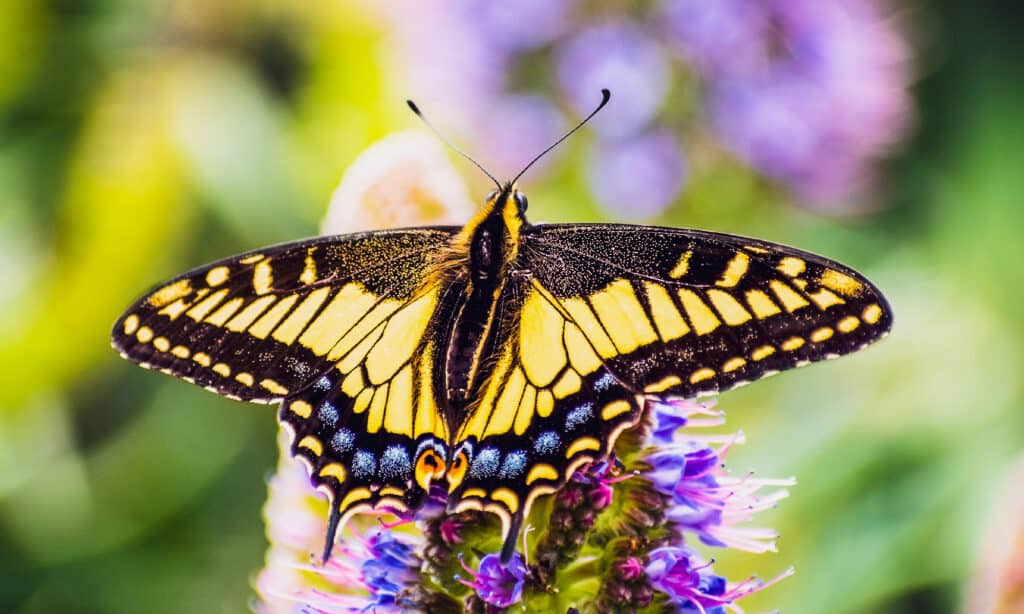
The Western Tiger Swallowtail Caterpillar eventually turns into a stunning
butterfly
.
©iStock.com/Sundry Photography
2. Brown-Tail Moth Caterpillar
The species found in specific parts of Washington is the Brown-Tail Moth Caterpillar. It is most commonly in the Western Lowlands and coastal areas. The caterpillar features a brownish color and distinctive tufts of hair along its back, making it visually intriguing. However, it is venomous. It possesses tiny, barbed hairs that can cause skin irritation and allergic reactions in some individuals upon contact.
It is best to observe these caterpillars safely away from any potential risk. If you are unintentionally exposed, it’s critical to thoroughly wash the afflicted area and get medical attention if you react badly. In areas where the Brown-Tail Moth Caterpillar lives, locals and visitors should exercise caution to reduce contacts and any potential health concerns this species may provide.
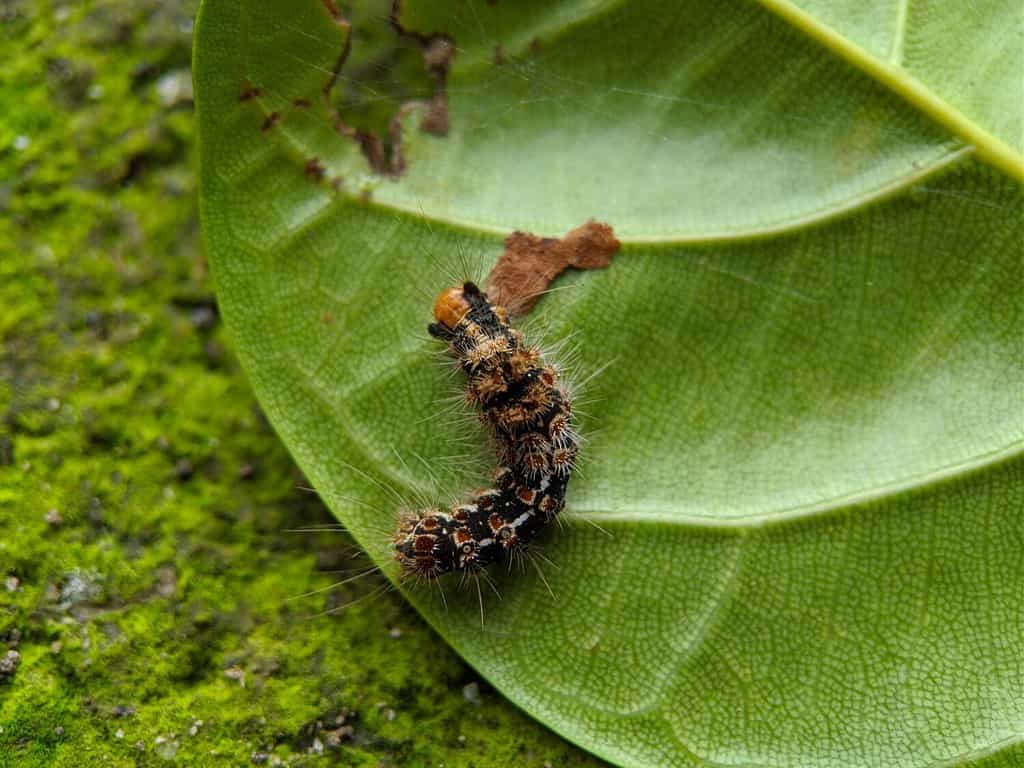
The brown-tail moth possesses tiny, barbed hairs that can cause skin irritation and allergic reactions in some individuals upon contact.
©Zikrieys Ahmad/Shutterstock.com
3. White-Marked Tussock Moth Caterpillar
The White-Marked Tussock Moth Caterpillar is a notable species in various areas of Washington State. It is commonly observed in the Western Lowlands, Cascade Mountains, and the Olympic Peninsula. This caterpillar stands out with its tufts of white and black hair, which give it a distinctive appearance.
Despite its intriguing look, the White-Marked Tussock Moth Caterpillar is not venomous. However, caution should still be exercised when handling it, as some individuals may experience skin irritation or allergic reactions due to contact with the caterpillar’s hair. It is best to admire this caterpillar from a safe distance to avoid any potential discomfort. The White-Marked Tussock Moth Caterpillar plays a role in the local ecosystem, and its presence in Washington’s diverse landscapes adds to the natural beauty and biodiversity of the region.

This caterpillar creates some allergic irritation but is not venomous.
©Satyashutter/Shutterstock.com
4. Saddleback Caterpillar
The Saddleback Caterpillar is a distinctive caterpillar species in specific regions of Washington. It is commonly in the Western Lowlands and along the coastal areas. This caterpillar is easily recognizable by its unique appearance, featuring a prominent green “saddle” on its back, outlined with pale-colored spots. However, despite its captivating appearance, the Saddleback Caterpillar is venomous. It possesses venomous spines on its body that can cause painful skin reactions and irritation upon contact. Avoid touching or handling this caterpillar to prevent potential discomfort or allergic reactions.
The Saddleback Caterpillar plays an important role in the ecosystem. However, it is essential to exercise caution and refrain from direct contact to ensure your safety. You can have an enjoyable experience when encountering this intriguing creature in the natural landscapes of Washington State without putting yourself at risk.
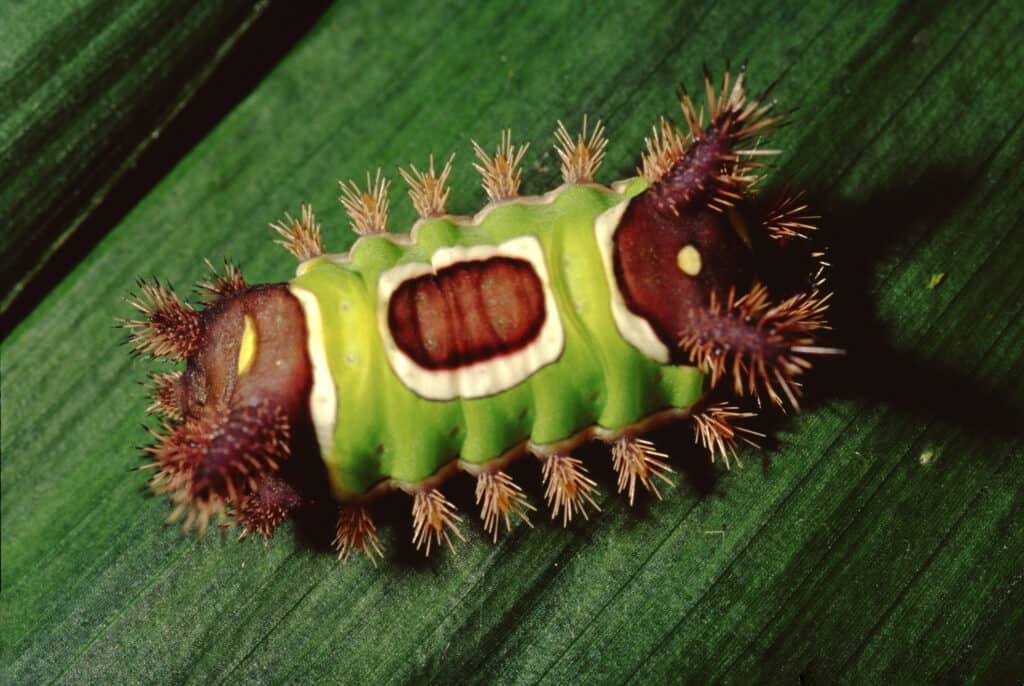
This caterpillar has a very strange appearance.
©Liz Weber/Shutterstock.com
5. Douglas-Fir Tussock Moth Caterpillar
The Douglas-Fir Tussock Moth Caterpillar is a notable species in specific areas of Washington. It is commonly in the forests of the Cascade Mountains and the Olympic Peninsula. This caterpillar has a distinctive appearance. It has tufts of hair on its back and a series of orange and white stripes along its body. While visually intriguing, the Douglas-Fir Tussock Moth Caterpillar is venomous. It possesses tiny, barbed hairs that can cause skin irritation and allergic reactions in some individuals upon contact.
As such, it is essential to avoid direct handling or touching these caterpillars to prevent potential discomfort or health issues. Despite its venomous nature, the Douglas-Fir Tussock Moth Caterpillar is a fascinating part of the diverse wildlife found in Washington State’s lush and wooded landscapes.

The Douglas-Fir Tussock caterpillar is commonly in the forests of the Cascade Mountains and the Olympic Peninsula.
©Zety Akhzar/Shutterstock.com
6. Io Moth Caterpillar
The Io Moth Caterpillar is a species in specific regions of Washington State. It is commonly spotted in the Western Lowlands and the coastal areas. This caterpillar possesses a distinctive appearance with its striking coloration, featuring lime-green and white stripes running along its body. While visually captivating, the Io Moth Caterpillar is venomous. It has spines on its body that release venom upon contact. This can potentially cause skin irritation and allergic reactions in some individuals.
Thus, direct handling of this caterpillar should be avoided to prevent discomfort and health issues. Despite its venomous nature, the Io Moth Caterpillar is a fascinating part of the local ecosystem, contributing to the biodiversity of Washington State’s natural habitats. When identifying this caterpillar in the wild, it is best to appreciate it from a safe distance to ensure a pleasant and safe experience in nature.
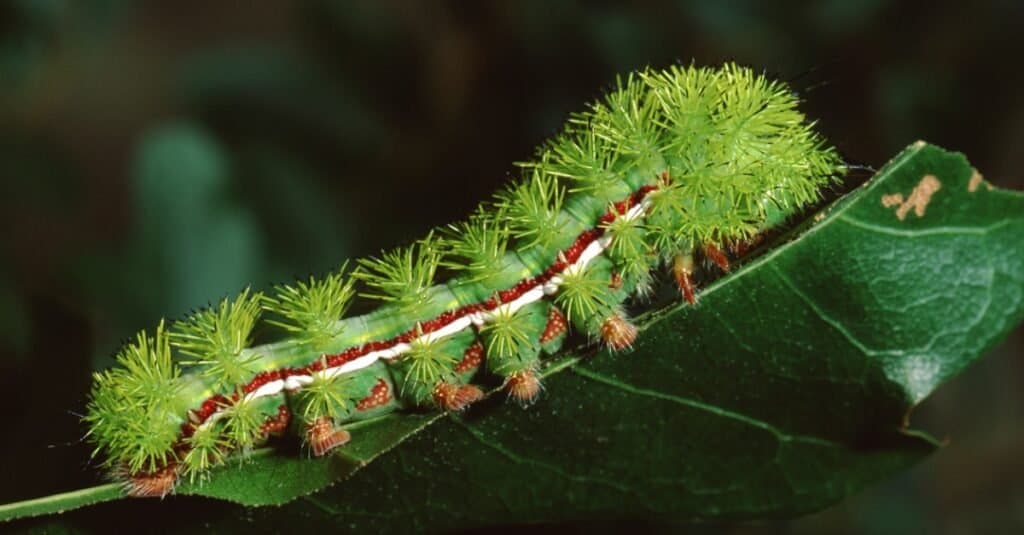
The IO moth caterpillar is commonly spotted in the Western Lowlands and the coastal areas of Washington state.
©iStock.com/Weber
7. Mourning Cloak Caterpillar
Washington State is home to a type of caterpillar known as the Mourning Cloak Caterpillar. It is frequently seen on the Olympic Peninsula, the Cascade Mountains, and the Western Lowlands. With its distinctive appearance, this caterpillar sticks out. It has a body that is dark brown or black and is covered in eye-catching red and white dots. The Mourning Cloak Caterpillar is not poisonous, unlike several other kinds of caterpillars, and it does not directly threaten people or other animals.
This caterpillar feeds on various host plants, contributing to the natural balance of the local ecosystem. When encountering the Mourning Cloak Caterpillar in the wild, it is best to observe and appreciate it from a safe distance, as handling any caterpillar can potentially cause skin irritation. This captivating caterpillar adds to the rich biodiversity of Washington State’s diverse landscapes and is an intriguing part of the region’s natural heritage.

The mourning cloak caterpillar is known for its black spikes.
©Massimiliano Paolino/Shutterstock.com
8. Pale Tiger Swallowtail Caterpillar
The Pale Tiger Swallowtail Caterpillar is a species commonly found in specific regions of the Pacific Northwest. It is primarily observed in the Western Lowlands and the coastal areas. This caterpillar stands out with its pale green color and striking black markings along its body. Unlike some other caterpillar species, the Pale Tiger Swallowtail Caterpillar is not venomous and does not pose a direct threat to humans or other animals.
This caterpillar feeds on different host plants. When viewing the Pale Tiger Swallowtail Caterpillar in the wild, it is best to observe and appreciate it from a safe distance, as handling any caterpillar can potentially cause skin irritation. This captivating caterpillar adds to the rich biodiversity of Washington State’s diverse landscapes and is an intriguing part of the region’s natural heritage.
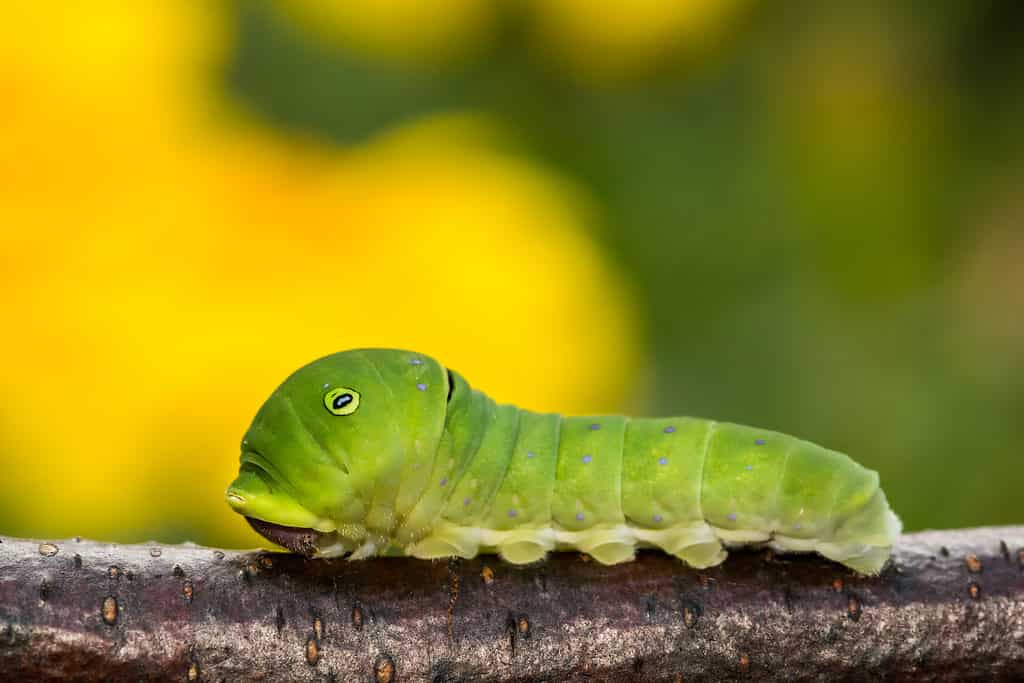
The Pale Tiger Swallowtail Caterpillar is nonvenomous and poses no direct threat to humans or other animals.
©Jay Ondreicka/Shutterstock.com
9. Painted Lady Caterpillar
The Painted Lady Caterpillar is a species commonly found in various areas of Washington State. It can be observed in the Western Lowlands, Cascade Mountains, and the Olympic Peninsula. This caterpillar showcases a unique appearance with its bristly black body adorned with vibrant orange and white stripes. Unlike some other caterpillar species, the Painted Lady Caterpillar is not venomous and poses no direct threat to humans or other animals.
This caterpillar feeds on several different host plants. When encountering the Painted Lady Caterpillar in the wild, it is best to admire it from a safe distance, as direct handling can cause skin irritation. This captivating caterpillar adds to the diversity of Washington State’s natural landscapes and is an enchanting part of the region’s wildlife.
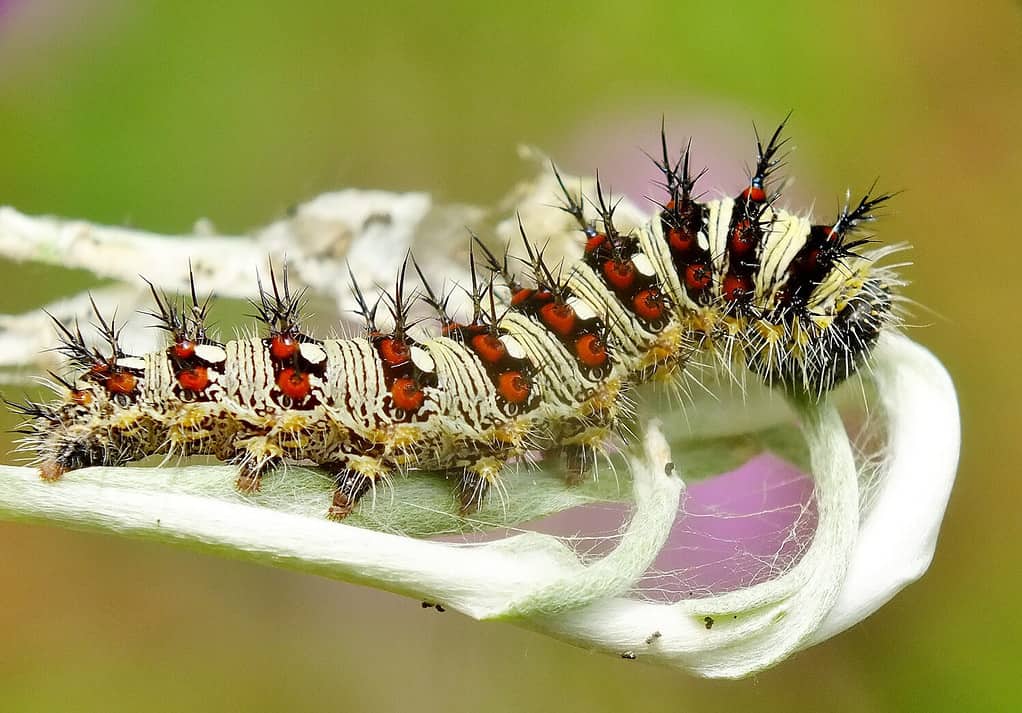
The Painted Lady Caterpillar has a very distinct appearance that makes it easy to identify.
©AnaGoncalves93/Shutterstock.com
10. Woolly Bear Caterpillar
The Wooly Bear Caterpillar is another well-known species that may be in many locations around Washington State. The Western Lowlands, the Cascade Mountains, and the Olympic Peninsula are potential locations. The peculiar look of this caterpillar, which has a black body with reddish-brown stripes running down its bristly surface, makes it stand out from other species. Contrary to certain other varieties of caterpillars, the Wooly Bear Caterpillar is not poisonous. Thus, it does not instantly pose a threat to people or other animals.
The Wooly Bear Caterpillar consumes a variety of plants, which helps maintain the ecosystem’s natural balance in the area. It is important to keep a safe distance when seeing the Wooly Bear Caterpillar in the field because touching any caterpillar might lead to skin discomfort. This curious caterpillar is an intriguing component of the region’s biological tapestry and adds to the variety of animals seen in Washington State’s natural environments.
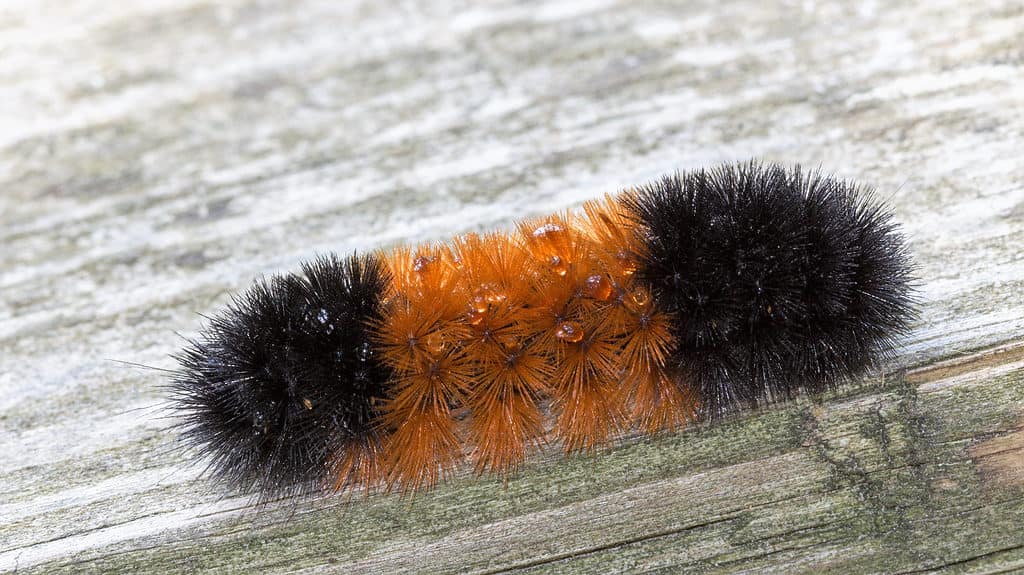
The Wooly Bear is not a picky eater, which is quite beneficial to the environment.
©Kimberly Boyles/Shutterstock.com
Summary of Caterpillars Found in Washington
| # | Caterpillar | Type |
|---|---|---|
| 1 | Western Tiger Swallowtail Caterpillar | Butterfly |
| 2 | Brown-tail Moth Caterpillar | Moth |
| 3 | White-Marked Tussock Moth Caterpillar | Moth |
| 4 | Saddleback Caterpillar | Moth |
| 5 | Douglas-fir Tussock Moth Caterpillar | Moth |
| 6 | Io Moth Caterpillar | Moth |
| 7 | Mourning Cloak Caterpillar | Butterfly |
| 8 | Pale Tiger Swallowtail Caterpillar | Butterfly |
| 9 | Painted Lady Caterpillar | Butterfly |
| 10 | Woolly Bear Caterpillar | Moth |
The photo featured at the top of this post is © Satyashutter/Shutterstock.com
Thank you for reading! Have some feedback for us? Contact the AZ Animals editorial team.






